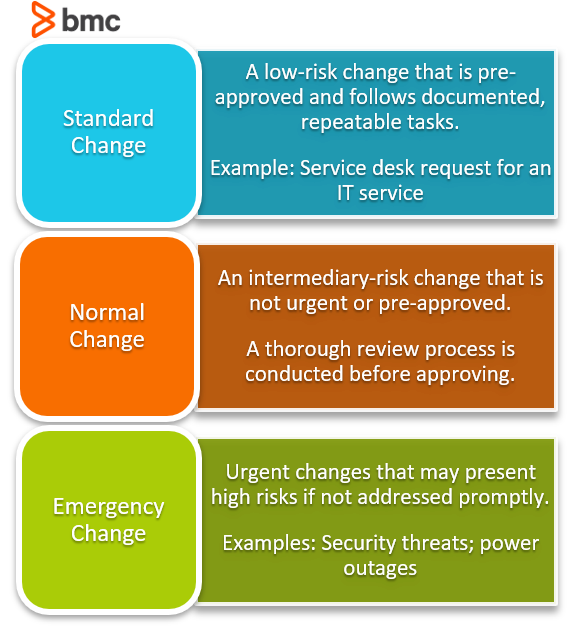Change Management Who Should Initiate Itsm, Application Development Team Or Operation Team?
Change enablement, also known as modify direction, is at the core of ITIL® service transition. The maturity of organisation depends on how well it facilitates alter requests (CR) in response to stop-user, technical, functional or wider concern requirements.
Careful change management helps reduce the adventure exposure and disruption proactively when new changes are instituted within your arrangement's operations and technologies.
ITIL provides an effective framework guideline to carry modify enablement and management activities. In this article, we will hash out the central roles and responsibilities involved in change management according to ITIL guidelines. Fifty-fifty if you don't adhere to the ITIL framework, these roles help clarify your alter direction processes.
We'll look at:
- The change manager
- Change informational lath (CAB)
- Emergency CAB
- The change process owner
- Alter direction teams
Alter manager
Modify managers are employees leading the change management programs. These leaders have a background in conducting structured change efforts in organizations.
A certification verifying alter management skill is typically desired for a change manager, who volition be involved in the following primal activities:
- Leading the alter management activities within a structured procedure framework.
- Designing the strategic approach to managing change and support operations that fall inside the domain of change management.
- Evaluating the change bear upon and organizational readiness to limit potential hazard.
- Supporting training and communication as function of alter direction. Activities may include designing or delivering specialized training resources to appropriate userbase.
- Evaluating the hazard of modify and providing actionable guidelines on reducing the bear on.
- Evaluating resistance in adopting the change at the user, process, and technology level.
- Managing the alter portfolio, which allows the organization to gear up for and successfully adopt the modify.
- Qualify pocket-sized change requests and coordinate with the Alter Informational Board for changes presenting higher hazard.
- Carry post-implementation reviews to assess the decisions and operation related to the change request.
Change Advisory Board (CAB)
This is the team that controls the lifecycle of change across all processes equally specified within ITIL Service Transition office. The Change Advisory Board involves high-level members from dissimilar domains, including information security, operations, development, networking, service desk, and concern relations, among others.
Together, the CAB is responsible for the following activities:
- Supporting the change managing director in decisions for major changes.
- Evaluating Requests for Change (RFCs), the available resources, impact of modify, and organizational readiness.
- Validating that appropriate tests and evaluation are performed earlier high-risk changes are canonical.
- Documenting relevant processes and activities.
- Supporting the design of change implementation scheduling.
- Reviewing a change implementation process.
- Supporting the pattern and approval new change procedure models.
- Using the diverse cognition base of operations, skills, and expertise of each CAB member to provide a unique perspective before a decision is finalized.

Emergency Change Advisory Board (ECAB)
The ECAB is a smaller body within the CAB that deals specifically with emergency changes. (Emergency changes are one of 3 change types according to ITIL.) When the emergency change request is raised, the change manager must conduct a thorough analysis and evaluation before finalizing a decision together with the CAB.
A defended ECAB body ensures that the necessary resources and expertise inside the CAB is bachelor to brand the correct decision at the correct time. The ECAB is responsible for performing activities equally similar to the CAB merely focused primarily on emergency changes. These include:
- Assessing the relative importance of the emergency change request.
- Supporting the modify managing director during impact and chance cess.
- Reviewing the change request, risk analysis, and bear on evaluation before the determination is finalized.
- Approving or rejecting an emergency modify.
- Evaluating the efficacy of the emergency change implementation procedure.
Alter process owner
The modify process possessor can have overlapping responsibilities with the ITIL Process Owner, specifically inside the role of change management. (For this reason, a divide change process owner may not exist required for small and midsize business organizations.)
The modify process owner is responsible for defining and supporting the overall process involved in change management. The activities include:
- Devising the process, in back up with the alter manager and CAB.
- Communicating the guidelines to appropriate stakeholders.
- Facilitating cross-departmental collaboration necessary for modify direction.
- Evaluating and improving the change management process.
- Reporting on the functioning of the process to CAB and change manager.
- Initiating process improvements.
The change management team
Change management functions are distributed in teams across departments and ITIL functions. Individuals within these teams may be responsible for managing change within a specific organizational unit of measurement considering their expertise, skills, and background.
Specific change management teams may consist of three roles:
- Change requestor. The individual responsible for initiating, preparing, and submitting a change request. This person may support collection of the necessary business organization information and engaging with the concerned stakeholders before the change request is assigned to the alter tester. Additionally, the change requestor also works with the alter management team to back up impact cess by collecting data and communicating with other stakeholders.
- Change possessor/assignee/implementor. The individual accounted every bit an owner of the CR throughout the request lifecycle. The modify tester may also accept the role of the Alter Requestor and back up the process for creating and submitting a modify request. The change owner ensures that the necessary tests accept been performed so that the change request is followed up past appropriate urgency. The modify owner would also certificate the process across the request life cycle.
- Alter approver. The individual responsible for the initial approval of a alter request earlier information technology is sent to the modify manager and CAB for a concluding conclusion. The change approver would communicate with other stakeholders and support the documentation before the request is sent to the change manager. This role is also generic and may be occupied by different individuals at various hierarchal levels of the alter management framework. At each level, the Modify Approver ensures that the change request has reached the necessary standard of readiness to warrant a conclusion by the alter manager and the CAB.
Additional resource
- BMC Service Direction Weblog
- BMC IT Operations Blog
- Change Management in the Cloud
- Change Enablement Process & Exercise: Essential Activities
- Lewin's Change Model in 3 Steps
- Organizational Change Management (OCM): A Template for Reorganizing Information technology
Explore IT careers, roles, certifications, salaries & more than!
This east-volume give you lot a basic understanding of It jobs, including tips for how to utilise and interview for IT positions and how to stay abrupt one time you've embarked on your career.

These postings are my own and do not necessarily correspond BMC'southward position, strategies, or opinion.
See an fault or accept a proposition? Delight allow u.s. know by emailing blogs@bmc.com.
BMC Bring the A-Game
BMC works with 86% of the Forbes Global 50 and customers and partners around the globe to create their time to come. With our history of innovation, industry-leading automation, operations, and service management solutions, combined with unmatched flexibility, we help organizations free upwardly time and space to become an Democratic Digital Enterprise that conquers the opportunities ahead.
Larn more about BMC ›
Source: https://www.bmc.com/blogs/change-management-roles/
Posted by: barbourwhered.blogspot.com



0 Response to "Change Management Who Should Initiate Itsm, Application Development Team Or Operation Team?"
Post a Comment